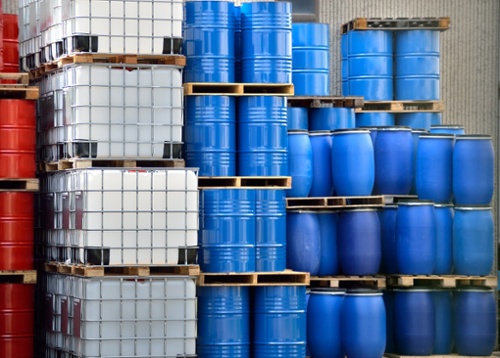When it comes to working safely with hazardous chemicals, keeping accurate records is key to reducing the likelihood and impact of an incident. The Register and Manifest of Hazardous Chemicals are two separate documents specified by Australian Work Health and Safety (WHS) Regulations. If your workplace is required to hold either of these documents, you must also make sure they are both kept up to date. This post explains the requirements of the WHS Regulations, so you can meet your safety obligations — and avoid up to $30,000 in fines for insufficient chemical documentation.
REMEMBER: Don’t forget that an update to either document probably indicates a change to the chemical hazards on the job site — which affects the level of risk to your workers. Be aware of changes in your workplace and re-assess the risk accordingly.
What is a Master Chemical Register?
So, what is a Register of Hazardous Chemicals, otherwise known as a Hazardous Chemical Register or Master Chemical Register?
The Register of Hazardous Chemicals is a simple list of all the hazardous chemicals used, stored, or handled at your worksite.
Hazardous Chemical Registers must contain the current safety data sheet (SDS) for each of the chemical products at your worksite. The primary purpose of the Register is for staff, who are using the chemicals or exposed to chemical hazards, to have ready access to safety, handling, and first aid information.

Your Register of Hazardous Chemicals needs to be current so staff can clearly identify correct procedures for handling and storage of chemicals, as well as first aid and emergency procedures.
You’re obligated under WHS law to make your Register available to staff — and keep it current and up to date.
“A person conducting a business or undertaking at a workplace must ensure that … the register is maintained to ensure the information in the register is up to date.”
Section 346 Model WHS Regulation
Keeping your Register of Hazardous Chemicals Updated
Now that you understand the Master Chemical Register meaning, what about some tips for keeping this document up to date?
To keep your Hazardous Chemical Register up to date, you’ll need to amend the document whenever:
- New chemicals are introduced to the job site.
- Chemicals are permanently discontinued.
- Safety Data Sheets (SDSs) have been amended or updated by the manufacturer or supplier.
We’ll now go into further detail about the situations that will lead to you updating your Hazardous Chemical Register.
Have New Chemicals Been Introduced?
Whenever new chemicals are introduced to the worksite you must do more than update the list of chemical names on the register: you’ll also need to obtain the SDS for the chemical and review any physical or health hazards.
For example, could the new chemical react dangerously with any of the substances you already have at the job site?
At the same time, you need to make sure your staff are aware that new chemicals are present onsite and understand the way they could affect their own health and safety.
New chemicals at the workplace may also trigger:
- Changes to your safety inductions
- Alterations to operations manuals and job sequences
- New locations for the Register
- Additional dangerous goods signage or hazard signage
- The need to have a Manifest of Hazardous Chemicals
WORKPLACE EXAMPLE: Your organisation wants to manufacture a new product which requires a flammable liquid (which is also corrosive) as part of the production process. The chemical has never used at the worksite before. Once it has been safely introduced to the workplace (SDS obtained, risk assessments conducted and control measures introduced, storage and decanting locations determined, staff training and PPE issued), the Register will also need to be updated.
Are Chemicals Obsolete?
Don’t keep obsolete chemicals listed on your Register of Hazardous Chemicals, if you stop using a substance (and it is completely removed from the worksite) it should be deleted from the Register.
You’ll need to delete the name of the chemical from the master list and remove copies of the safety data sheet. Hazardous substances used periodically or seasonally (even if not onsite) can stay on the Register.
WORKPLACE EXAMPLE: Your organisation decides to outsource the cleaning of the offices and administration buildings. Cleaning is carried out when the premises are closed and the cleaning company use their own chemicals which are stored offsite. The cleaning chemicals originally used by in-house staff (after they are completely removed from site) can be deleted from the Register.
How Often Do Safety Data Sheets Need To Be Updated?
You’re required, under Australian WHS law in your state or territory, to have current safety data sheets for each chemical available for your staff to access. A current safety data sheet is one that has been updated every 5 years.
Safety data sheets must be available to staff and updated every 5 years.
Updating Safety Data Sheets (SDS)
Manufacturers and importers of hazardous chemicals are required to review and update the details in their chemical safety data sheets every 5 years.
The safety data sheet will include the date in which it was last reviewed and updated. You can generally find this date in Section 16 of your safety data sheet.
You should be aware that manufacturers are required by law to update a safety data sheet:
- If new information emerges about the chemical (often from scientific research projects).
- When changes are made to the formulation (mix of chemical ingredients).
- Every five years (from original preparation date or the last revision date).
IMPORTANT: Changes to the SDS will almost always affect the chemical hazards at the workplace. When there are any changes to your safety data sheets, make sure that you’re following safety procedures to re-assess your workplace for risk ie. Incompatible substances, new potential health hazards etc.
Record Issue or Amendment Date of Each Safety Data Sheets
We suggest recording the issue/amendment date of each SDS on the Register master list which you can quickly review during periodic audits and site inspections.
Using the advanced search feature on the Hazardous Chemical Information System (HCIS) — which can display search results for chemicals based on their last review date — is an effective way of ensuring your Register is always up-to-date.
REMEMBER: We recommend keeping your safety data sheets in a folder, kept within a durable and waterproof document holder. You may be able to attach the document holder to your safety cabinet or outdoor chemical store, so your staff don’t have to waste time searching for the correct SDS.
Update both Electronic and Hard Copy Versions of Your Chemical Register
When updating your Register, make sure the changes are reflected everywhere the Register is stored. This means checking that electronic updates to the Register are reflected on the hard copy Registers, as well as the information given to individual workstations.

Make sure that all copies of your Hazardous Chemical Register are updated when there are changes to your safety data sheets.
What is a Manifest Of Hazardous Chemicals?
The Manifest of Hazardous Chemicals is required if your workplace exceeds threshold limits, as defined in the WHS Regulation.
Your Manifest’s primary purpose is to notify emergency crews (responding to fires, chemical emergencies or other dangerous events) of chemical hazards and the quantities of Dangerous Goods kept onsite.
Because the Manifest also includes a site map (drawn to scale), you’ll also need to update your Manifest if the site map changes in any way.
“A person conducting a business or undertaking at a workplace must …amend the manifest as soon as practicable if the type or quantity of hazardous chemicals changes; or there is a significant change in the information required to be recorded in the manifest.”
Section 347 WHS Regulations
How To Update Your Manifest Of Hazardous Chemicals
Amend the Hazardous Chemical Manifest when changes are made to reportable information.
Some examples of circumstance which may trigger an update to your Manifest of Hazardous Chemicals includes:
- A change in management or site ownership.
- After hours contact details are updated.
- Renovations or construction change the physical layout of the work site.
- Damage from natural disaster (flood, cyclone) or emergency situation (fire, building collapse) alters the job site.
- Council or a utility company change an access point or exit.
- Changes to chemical quantities.
IMPORTANT: Update your Manifest of Hazardous Chemicals as soon as practicable if chemical quantities change. This is for your safety, as well as WHS compliance.
Updating Your Emergency Plan
Keep in mind that these changes with chemical quantities may increase the level of risk to your workers. Therefore, your entire Emergency Plan may also require auditing.
Examples of circumstances which may require an audit of your Emergency Plan include:
- An increase or decrease to the quantities of Manifest chemicals (eg, flammable liquids, toxic gases, organic peroxides)
- Changes to the way the chemicals are stored (eg, installation of bulk tanks)
- Changes to Dangerous Goods in transit
- Changes to manufacturing output and processing capacity
When you reissue your Manifest of Hazardous Chemicals, you need to:
- Change the ‘Last amendment date’.
- Notify emergency services (if there has been a significant change to the level of risk); and
- Remove the old Manifest from designated storage area and replace with the new one.
TIP: For full details of how to prepare and implement a legally compliant Manifest, you can read our popular post, Does your workplace need a manifest of hazardous chemicals?
Compliance with Chemical Manifests and Hazardous Chemical Registers
The Register and Manifest of Hazardous Chemicals are both important documents that assist you in providing a safe workplace. Like to learn more about chemical compliance and risk managment? Simply download our free eBook, How to manage the risk of Hazardous Chemicals in the workplace, to find out more.
Joining the team as a Dangerous Goods Storage Consultant, Melissa Hampton became Storemasta's Marketing Manager in late 2021. With extensive knowledge and experience in chemical compliance, Melissa is responsible for leading the Marketing team and helping shape their marketing strategy. In her spare time, you can find Melissa hiking, swimming and enjoying the great outdoors in beautiful north-west Tasmania.

